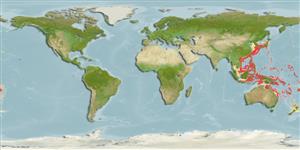Environment: milieu / climate zone / depth range / distribution range
Ökologie
seewasser demersal; tiefenbereich 60 - 400 m (Ref. 9792). Deep-water
Northwest Pacific: Japan, Taiwan, and China near Hainan. Reported from the Philippines (Ref. 11148) and South Korea (Ref. 77001).
Size / Gewicht / Alter
Maturity: Lm ? range ? - ? cm
Max length : 19.0 cm TL Männchen/unbestimmt; (Ref. 9792)
Upper-jaw length 3.4 to 3.9 times in head length (Ref 12933).
Found on sand-mud bottoms. Very rare. Feeds on small benthic animals (Ref. 9792).
Life cycle and mating behavior
Geschlechtsreife | Fortpflanzung | Ablaichen | Eier | Fecundity | Larven
Hensley, D.A., 1997. Pleuronectidae. Righteye flounders. In K.E. Carpenter and V. Niem (eds.) FAO Identification Guide for Fishery Purposes. The Western Central Pacific. (Ref. 9792)
IUCN Rote Liste Status (Ref. 130435: Version 2024-1)
Bedrohung für Menschen
Harmless
Nutzung durch Menschen
Fischereien: nicht kommerziell
Tools
Zusatzinformationen
Download XML
Internet Quellen
Estimates based on models
Preferred temperature (Ref.
123201): 13.1 - 24.6, mean 19.1 °C (based on 277 cells).
Phylogenetic diversity index (Ref.
82804): PD
50 = 0.5000 [Uniqueness, from 0.5 = low to 2.0 = high].
Bayesian length-weight: a=0.01995 (0.00906 - 0.04395), b=3.01 (2.83 - 3.19), in cm total length, based on all LWR estimates for this body shape (Ref.
93245).
Trophic level (Ref.
69278): 3.5 ±0.37 se; based on food items.
Fishing Vulnerability (Ref.
59153): Low vulnerability (10 of 100).
